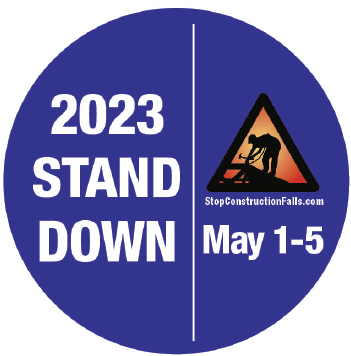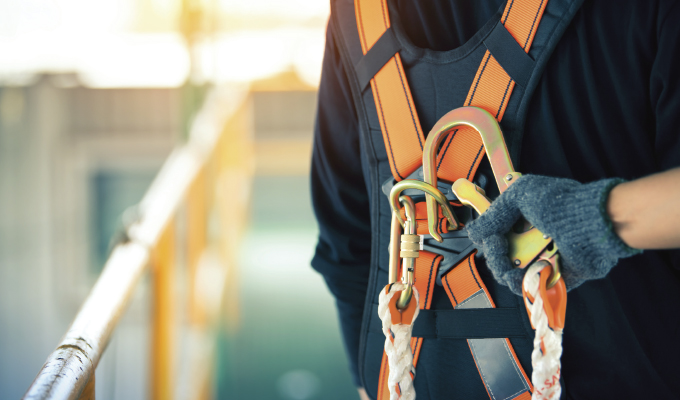Falls continue to be the number one cause of jobsite deaths in construction, accounting for 35% of total fatalities from 2011 to 2020, according to data from CPWR – The Center for Construction Research and Training. Put another way, during that period more than 3,300 workers died from a fall—such as from a ladder, scaffolding, or a roof. While the underlying causes of falls are many and varied, there are key actions employers can take to prevent them and to better protect workers if they occur.
In a survey of more than 400 industry members CPWR conducted in 2020, respondents highlighted insufficient or ineffective planning as a significant contributor to falls. The odds of workers using fall protection were 71% lower for individuals whose employer or competent person did not implement a fall protection plan.
CREATING A PLAN
For those who may be new to fall prevention planning or want to improve existing plans, CPWR has developed many resources that are available for free at stopconstructionfalls.com. The site’s Plan Provide Train section includes checklists and templates to help contractors begin planning to prevent falls before construction ever begins, including information on providing the right access equipment and PPE like fall harnesses, as well as Toolbox Talks, videos, and handouts to better train workers. Most of these resources are available in English and in Spanish.

LEADERSHIP IS CRITICAL
In addition to creating a plan, it’s critical that people in leadership positions support and help implement it. Both upper management and frontline crew leaders must be invested in the plan and lead by example. The 2020 survey found that employee beliefs about their company’s fall protection policy are strongly associated with the degree to which protective equipment is used on the jobsite. Respondents who believed their employer required fall protection were eight times more likely to use it than those who did not believe it was required.
SAFETY CLIMATE
Planning and organizational commitment are central elements of jobsite safety climate. To help build a strong safety climate, CPWR developed the Foundations for Safety Leadership (FSL) course, which has now reached over one million construction workers. The highly interactive FSL training teaches crew leaders about the costs of ineffective, and the benefits of effective, safety leadership. The content covers six critical leadership skills they can use on the jobsite, including how to lead by example and communicate with crew members, to improve safety climate and safety outcomes. The just-released Foundations for Safety Leadership for Residential Construction (FSL4Res) training builds on the FSL but locates its scenarios on residential construction sites, focuses on fall protection, and can be presented in a single 2.5-hour session, like the FSL, or in five 30-minute sessions.
Fall prevention should be a focus year-round, and the upcoming 10th annual National Safety Stand-Down, taking place May 1–5, 2023, provides companies with a great opportunity to pause work, conduct training, reevaluate fall prevention and rescue plans, and review policies with employees. The Stand-Down is the main event associated with the OSHA-NIOSH-CPWR National Campaign to Prevent Falls in Construction, which since 2014 has reached millions of workers each year in the U.S. and abroad. The One-Stop Stand-Down Shop section of the stopconstructionfalls.com has everything a company needs to conduct an effective and fun Stand-Down. This year, the free materials include a new Stand-Down Plan and more social media resources, to be posted closer to the event. Also, participants can order free hardhat stickers and pocket-sized hazard alert cards on a variety of fall-related topics.
CLOSING THOUGHT
Construction falls ARE preventable. By planning, providing the right equipment, and properly training employees, you can be part of the solution.
SOURCES:
CPWR. [2022]. Focus Four Data Dashboard. www.cpwr.com/research/data-center/data-dashboards/construction-focus-four-dashboard/.
CPWR. [2022]. Highlighted Findings from a CPWR Survey on Underlying Causes of Falls from Heights. www.cpwr.com/wp-content/uploads/RR-falls_experience_survey.pdf.
CPWR. [2022]. Highlighted Findings from a CPWR Survey on Underlying Causes of Falls from Heights. www.cpwr.com/wp-content/uploads/RR-falls_experience_survey.pdf.
About the Author:
Jessica Bunting is CPWR’s research to practice director, focusing on accelerating the adoption of research findings and evidence-based solutions by employers and their employees to prevent occupational injuries and illnesses. Her work responds to hazards such as falls, musculoskeletal disorders, and struck-by incidents, including by leading development of resources such as Hazard Alert Cards, Toolbox Talks, and infographics. As director of research and evaluation, Dr. Linda M. Goldenhar leads CPWR’s safety climate research, which includes creating the popular Foundations for Safety Leadership a training module for frontline supervisors; developing CPWR’s valid and reliable climate assessment tools; and, most recently, creating the Safety Climate-Safety Management Information System. Bill Wright is CPWR’s communications director.
Modern Contractor Solutions, February 2023
Did you enjoy this article?
Subscribe to the FREE Digital Edition of Modern Contractor Solutions magazine.



